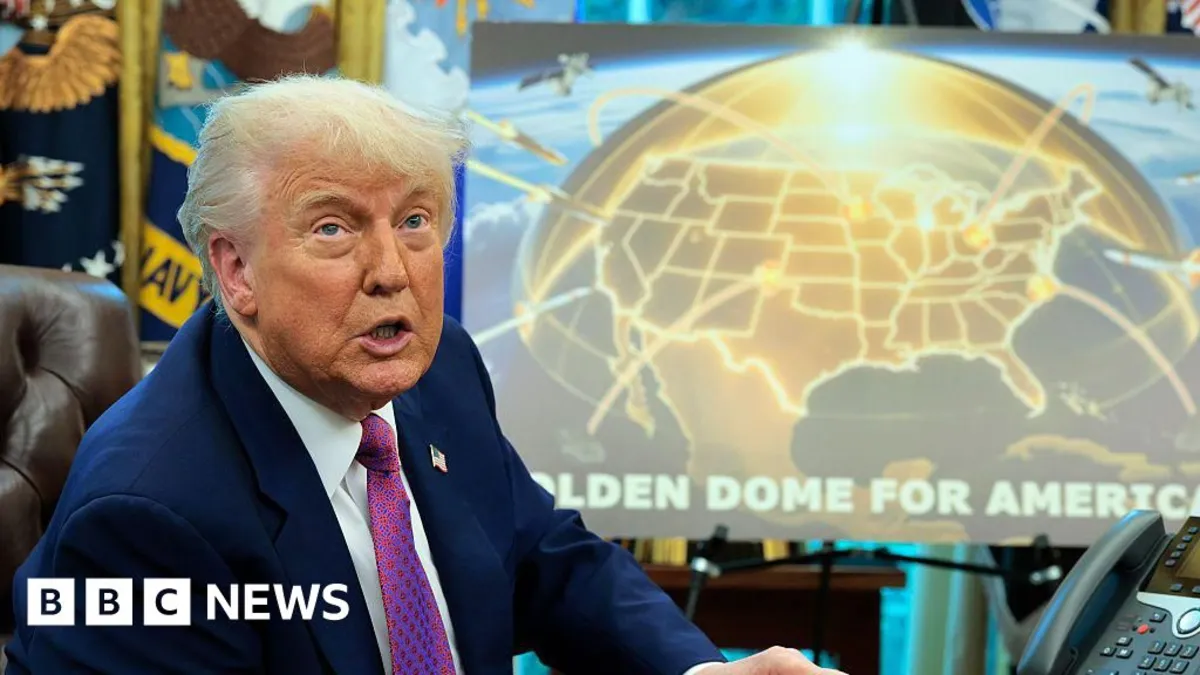
In a world increasingly threatened by advanced military technologies, the concept of a missile defense system known as the 'Golden Dome' has emerged as a critical focus for US President Donald Trump. With the specter of warheads raining down from beyond the earth's atmosphere, experts warn of alarming scenarios that could materialize if the US's outdated and limited defense systems were to be overwhelmed in a high-tech attack.
Among the most unsettling possibilities is the detonation of a relatively small nuclear device hundreds of miles above the US, resulting in an electromagnetic pulse (EMP) that could have catastrophic effects. Such an event would incapacitate everything from handheld electronics to essential medical devices and water systems, plunging society into chaos. According to William Fortschen, an author and weapons researcher, this would not merely be a return to a simpler time; it would represent a regression of a millennium, with society losing its foundational technologies and knowledge.
In response to these potential threats, President Trump has proposed the creation of the Golden Dome, a next-generation missile defense shield. While many experts agree that a robust defense system is essential, they also caution that the high costs and logistical complexities involved pose significant challenges to its realization. An executive order advocating for the initial concept, which was dubbed the Iron Dome for America, highlighted the escalating intensity and complexity of modern threats.
Patrycja Bazylczyk, a missile defense expert at the Center for Strategic and International Studies, noted that existing systems are primarily designed to counter intercontinental ballistic missiles (ICBMs), like those posed by North Korea. However, major powers like Russia and China are developing advanced technologies that can target adversaries across oceans. US defense officials have highlighted emerging threats such as hypersonic weapons and fractional orbital bombardment systems (FOBs) that can deliver warheads from space. These advancements necessitate a recalibration of the US's missile defense strategy.
Details about what the Golden Dome will entail remain vague as the project is still in its conceptual stages. During a meeting in the Oval Office, Defense Secretary Pete Hegseth stated that the system would include multiple layers across land, sea, and space, incorporating space-based sensors and interceptors. Trump emphasized that the system aims to intercept missiles launched from distant locations, even from space, with various components possibly stationed in states such as Florida, Indiana, and Alaska.
Currently, the US relies on 44 ground-based interceptors located in Alaska and California to combat limited missile threats. However, experts warn that this setup is insufficient against a large-scale attack, particularly from nations like Russia and China, which possess extensive arsenals of ICBMs and cruise missiles. Dr. Stacie Pettyjohn from the Center for a New American Security pointed out that the current systems were designed with North Korea in mind and are incapable of handling the scale of threats posed by larger adversaries.
Trump's vision for the Golden Dome draws inspiration from Israel’s Iron Dome, a system that has successfully countered short-range threats since 2011. However, while the Iron Dome focuses on intercepting shorter-range missiles, the Golden Dome aims to extend its capabilities to longer-range missile detection and interception. Bazylczyk emphasized the need for a command and control system that can effectively integrate these various capabilities, which currently does not exist.
Establishing the Golden Dome presents significant complications, both in terms of technology and finances. Trump has suggested that the system could be operational by the end of his term, estimating a total cost of $175 billion, including an initial $25 billion investment. However, the Congressional Budget Office (CBO) estimates that the cost could soar to $542 billion over 20 years for space-based systems alone. Experts warn that the ambitious timeline and budget could severely strain the US defense budget and lead to unforeseen challenges.
The proposed Golden Dome raises concerns about a potential arms race, as adversaries may intensify their efforts to develop capabilities that can overwhelm or bypass the new defenses. Chinese officials have already expressed concerns that the plan could escalate tensions in space. However, experts argue that potential adversaries are already investing heavily in offensive capabilities, and the Golden Dome could serve as a deterrent, altering the strategic calculations of adversaries and enhancing overall security.
Even a partially completed Golden Dome could help mitigate the risks posed by incoming missile threats, providing a sense of security to the American populace. As Fortschen noted, the system represents a necessary step forward in ensuring national safety. With the right investments and strategic planning, the Golden Dome could indeed be the answer to safeguarding America against the evolving landscape of global threats.